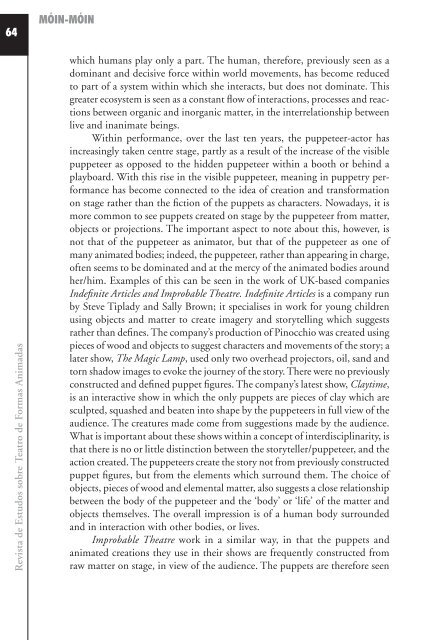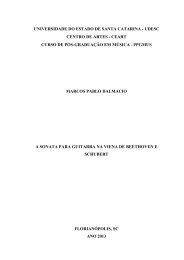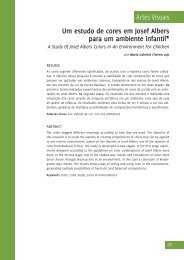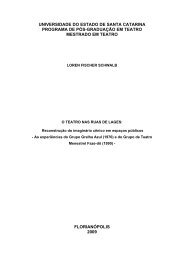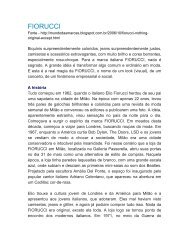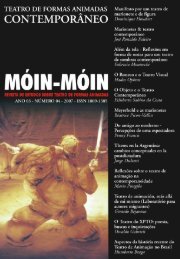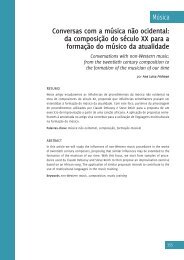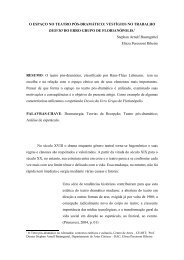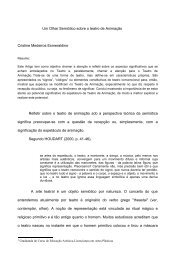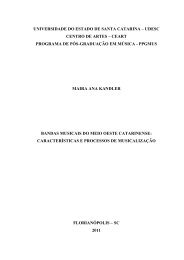Edição e distribuição www.designeditora.com.br Tipologia Adobe ...
Edição e distribuição www.designeditora.com.br Tipologia Adobe ...
Edição e distribuição www.designeditora.com.br Tipologia Adobe ...
You also want an ePaper? Increase the reach of your titles
YUMPU automatically turns print PDFs into web optimized ePapers that Google loves.
64<<strong>br</strong> />
Revista de Estudos so<strong>br</strong>e Teatro de Formas Animadas<<strong>br</strong> />
MÓIN-MÓIN<<strong>br</strong> />
which humans play only a part. The human, therefore, previously seen as a<<strong>br</strong> />
dominant and decisive force within world movements, has be<strong>com</strong>e reduced<<strong>br</strong> />
to part of a system within which she interacts, but does not dominate. This<<strong>br</strong> />
greater ecosystem is seen as a constant flow of interactions, processes and reactions<<strong>br</strong> />
between organic and inorganic matter, in the interrelationship between<<strong>br</strong> />
live and inanimate beings.<<strong>br</strong> />
Within performance, over the last ten years, the puppeteer-actor has<<strong>br</strong> />
increasingly taken centre stage, partly as a result of the increase of the visible<<strong>br</strong> />
puppeteer as opposed to the hidden puppeteer within a booth or behind a<<strong>br</strong> />
playboard. With this rise in the visible puppeteer, meaning in puppetry performance<<strong>br</strong> />
has be<strong>com</strong>e connected to the idea of creation and transformation<<strong>br</strong> />
on stage rather than the fiction of the puppets as characters. Nowadays, it is<<strong>br</strong> />
more <strong>com</strong>mon to see puppets created on stage by the puppeteer from matter,<<strong>br</strong> />
objects or projections. The important aspect to note about this, however, is<<strong>br</strong> />
not that of the puppeteer as animator, but that of the puppeteer as one of<<strong>br</strong> />
many animated bodies; indeed, the puppeteer, rather than appearing in charge,<<strong>br</strong> />
often seems to be dominated and at the mercy of the animated bodies around<<strong>br</strong> />
her/him. Examples of this can be seen in the work of U-based <strong>com</strong>panies<<strong>br</strong> />
Indefinite Articles and Improbable Theatre. Indefinite Articles is a <strong>com</strong>pany run<<strong>br</strong> />
by Steve Tiplady and Sally Brown; it specialises in work for young children<<strong>br</strong> />
using objects and matter to create imagery and storytelling which suggests<<strong>br</strong> />
rather than defines. The <strong>com</strong>pany’s production of Pinocchio was created using<<strong>br</strong> />
pieces of wood and objects to suggest characters and movements of the story; a<<strong>br</strong> />
later show, The Magic Lamp, used only two overhead projectors, oil, sand and<<strong>br</strong> />
torn shadow images to evoke the journey of the story. There were no previously<<strong>br</strong> />
constructed and defined puppet figures. The <strong>com</strong>pany’s latest show, Claytime,<<strong>br</strong> />
is an interactive show in which the only puppets are pieces of clay which are<<strong>br</strong> />
sculpted, squashed and beaten into shape by the puppeteers in full view of the<<strong>br</strong> />
audience. The creatures made <strong>com</strong>e from suggestions made by the audience.<<strong>br</strong> />
What is important about these shows within a concept of interdisciplinarity, is<<strong>br</strong> />
that there is no or little distinction between the storyteller/puppeteer, and the<<strong>br</strong> />
action created. The puppeteers create the story not from previously constructed<<strong>br</strong> />
puppet figures, but from the elements which surround them. The choice of<<strong>br</strong> />
objects, pieces of wood and elemental matter, also suggests a close relationship<<strong>br</strong> />
between the body of the puppeteer and the ‘body’ or ‘life’ of the matter and<<strong>br</strong> />
objects themselves. The overall impression is of a human body surrounded<<strong>br</strong> />
and in interaction with other bodies, or lives.<<strong>br</strong> />
Improbable Theatre work in a similar way, in that the puppets and<<strong>br</strong> />
animated creations they use in their shows are frequently constructed from<<strong>br</strong> />
raw matter on stage, in view of the audience. The puppets are therefore seen


